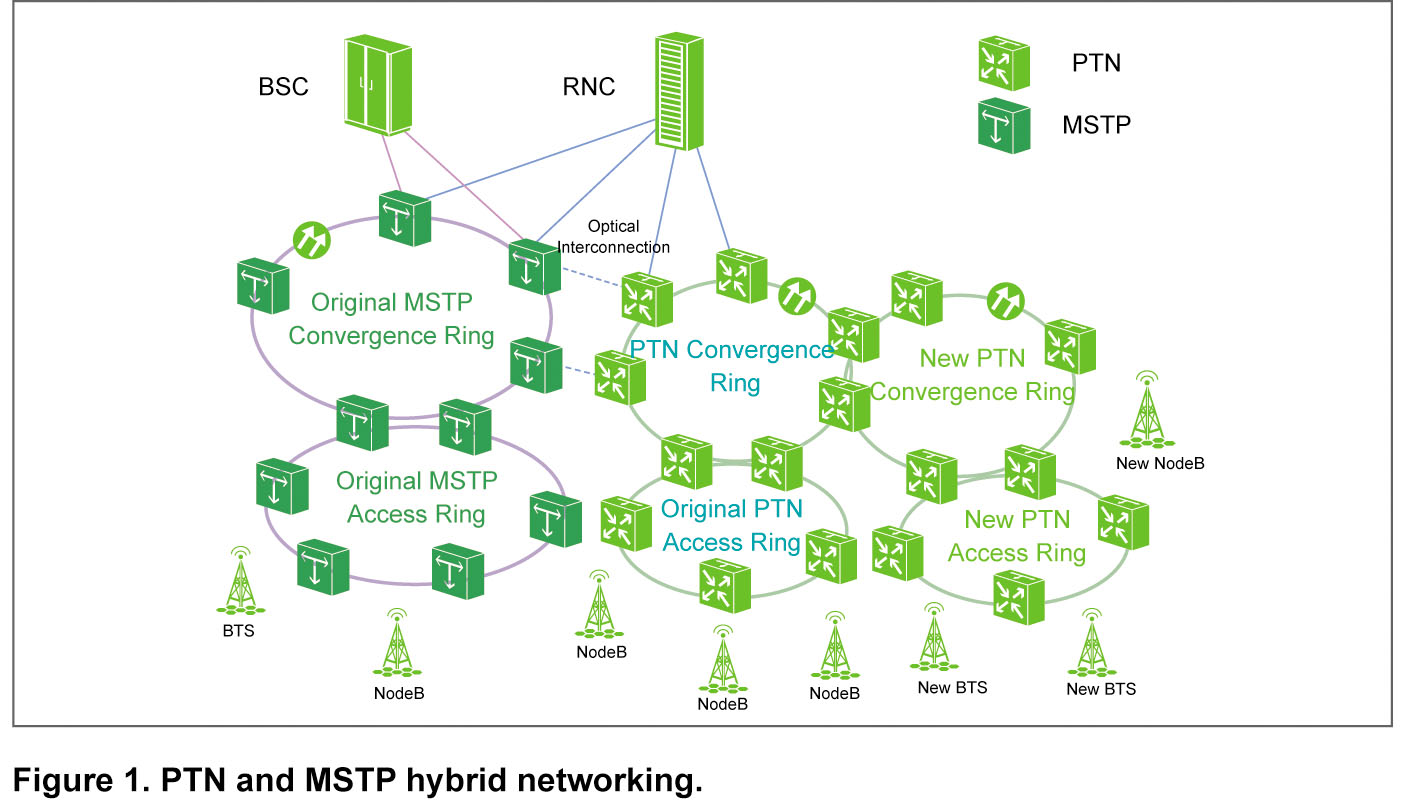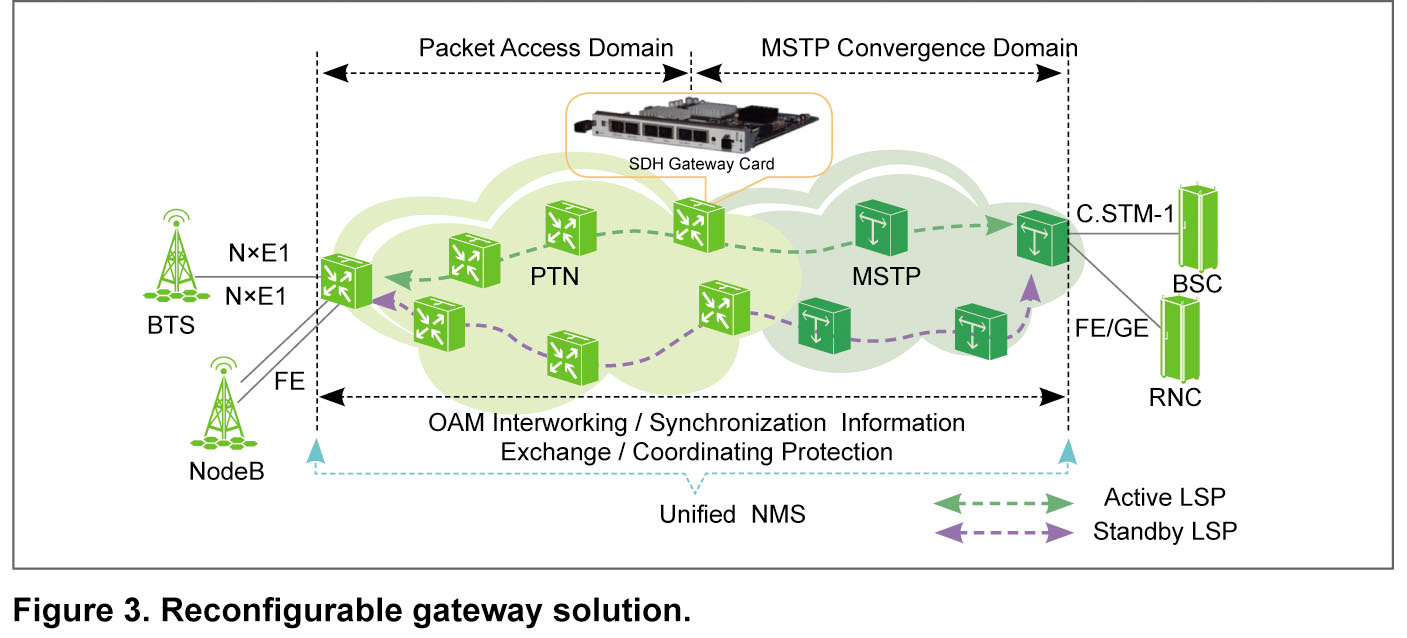A Reconfigurable Gateway for the Coexistence of PTN and MSTP
Challenges for Operators
As 3G mobile services develop and deployment of LTE networks rapidly approaches, a next generation Packet Transport Network (PTN) technology is necessary for operators to reduce TCO and enhance the competitiveness of their mobile broadband networks. Since conventional SDH networks will coexist with IP-based networks for some time to come, smooth evolution from SDH to PTN is a key issue that needs addressing.
Considering the long-term coexistence of 2G and 3G, the most simple way to capitalize on existing network infrastructure is to carry 2G voice services over SDH, and 3G and EOS services over PTN. To accommodate the expansion of 2G services, 2G BTSs must be built or EOS services swapped from SDH to PTN.
When PTN is used to bear services at the new BTS side, there may not be any idle STM-1 interface at the BSC side for connection with PTN. As a result, services sent from BTS to BSC may not be transmitted through equipment at the PTN core layer, but rather through the original 10G/2.5G MSTP at the core layer.
Because EOS services are transported over SDH, substantial bandwidth is consumed. If these services are swapped to PTN, which is more suitable for data service bearing, more SDH bandwidth resource would be available for 2G services.

To make full use of bandwidth resource in MSTP and to address the above networking issue, a PTN and MSTP hybrid networking solution (see Figure 1) is a good solution. The following issues must be considered:
■ How to enable cross-domain traffic transfer between BTS and BSC
■ How to provide cross-domain end-to-end (BTS to BSC) protection
■ How to realize cross-domain NMS interconnection between PTN and MSTP
■ How to convert OAM information between PTN and MSTP
Non End-to-End Interconnection Solution
PTN and SDH implement pseudo-wire decapsulation through the STM-1 or STM-4 interface and the original E1 signals are recovered for transmission. Because MSTP and PTN belong to two separate rings—PTN access ring and MSTP convergence ring—they perform intra-domain traffic scheduling respectively. Traffic from BTS to BSC is configured separately for network management. E1 to VC12 end-to-end traffic is configured for PTN, while VC12 to VC12 end-to-end traffic is configured for MSTP. The MSTP and PTN rings are independently protected.

A non end-to-end interconnection solution (see Figure 2) is easy to implement and deploy on the existing network. No alteration to existing PTN and MSTP is necessary. However, the solution has high risks in network topology. Single node failure may occur between the PTN access ring and MSTP convergence ring, and this may lead to service discontinuity between BTS and BSC. Moreover, the solution fails to provide end-to-end protection, end-to-end OAM, or NMS interconnection between PTN and MSTP. Any network failure entails layer-by-layer troubleshooting. This affects rapid fault locating, recovery, and QoS.
Reconfigurable Gateway Solution
ZTE has launched a reconfigurable gateway solution for interworking between a newly-built PTN and existing MSTP. The solution provides unified NMS, service and OAM information conversion, end-to-end protection, and clock synchronization. These help operators integrate existing resources and realize smooth evolution of networks (see Figure 3).

In China Mobile’s 2G/3G backhaul network, MSTP was first deployed at the convergence layer where there is redundant bandwidth. At the access layer, where bandwidth is scarce, a new PTN has to be built. To protect China Mobile’s initial investment, ZTE supplied a reconfigurable SDH gateway for MSTP and PTN hybrid networking, which allowed the transfer of both 2G and 3G services.
ZTE’s reconfigurable gateway solution has advantages over a traditional tunnel solution:
■ Low cost and easy deployment: The reconfigurable SDH gateway has low-cost hardware that meets high technical requirements. It can be easily deployed with no change to MSTP topology and without impacting existing traffic.
■ Cross-domain traffic transfer: PTN supports a reconfigurable SDH gateway. After PTN simulation, TDM traffic is converted into E1 signals, which are first transferred to PTN gateway nodes, then to MSTP through the STM-1/4 SDH interfaces, and finally to BSC. In this way, traffic encapsulation overhead is saved and bandwidth utilization is increased.
■ End-to-end OAM: A reconfigurable SDH gateway makes it possible to convert PW alarms in the PTN domain into VC12 alarms in the MSTP domain, and vice versa. This helps implement end-to-end alarm management, and end-to-end OAM of network devices of different vendors.
■ End-to-end protection: End-to-end protection can be realized through SDH protection and PTN protection as well as interoperability of PW 1+1 protection and MSTP VC-12/VCG 1+1 protection.
■ Cross-domain NMS interconnection: The interworking of Data Communication Network (DCN)—PTN’s NMS—and Data Communication Channel (DCC) of MSTP allows fast fault locating and recovery.
The reconfigurable gateway solution meets customer requirements for high performance, low cost, and low power consumption. It supports easy and flexible deployment in the newly-built PTN without impacting existing services, and provides reliable end-to-end protection, rich OAM functions, fast troubleshooting, and convenient end-to-end management. Because EOS services are smoothly swapped to PTN, SDH bandwidth resources are saved for bearing 2G voice services, and this helps operators protect their investments in SDH.